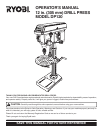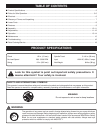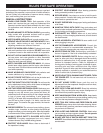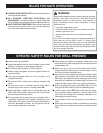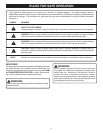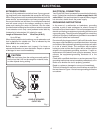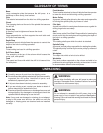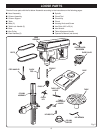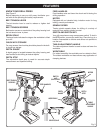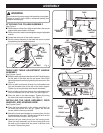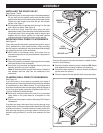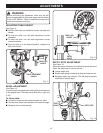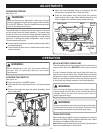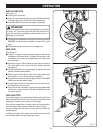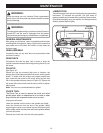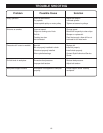
4
■ ALWAYS TURN SWITCH OFF before disconnecting it to
avoid accidental starting.
■ ALL REPAIRS, WHETHER ELECTRICAL OR
MECHANICAL, should be made at a Ryobi Authorized
Service Center. Use only Ryobi identical replacement parts.
■ SAVE THESE INSTRUCTIONS. Refer to them frequently
and use to instruct other users. If you loan someone this
tool, loan them these instructions also.
RULES FOR SAFE OPERATION
WARNING:
Some dust created by power sanding, sawing, grinding,
drilling, and other construction activities contains
chemicals known to cause cancer, birth defects or
other reproductive harm. Some examples of these
chemicals are:
• lead from lead-based paints,
• crystalline silica from bricks and cement and other
masonry products, and
• arsenic and chromium from chemically-treated
lumber.
Your risk from these exposures varies, depending on
how often you do this type of work. To reduce your
exposure to these chemicals: work in a well ventilated
area, and work with approved safety equipment, such
as those dust masks that are specially designed to filter
out microscopic particles.
■ Always wear eye protection.
■ Always disconnect the tool from the power source when
setting up, adjusting, or changing accessories.
■ Do not wear gloves necktie, or loose clothing.
■ Always clamp workpiece and brace against column to
prevent rotation.
■ Use recommended speed for drill accessory and
workpiece material.
■ Be sure drill bit or cutting tool is securely locked in the
chuck.
■ Be sure chuck key is removed from the chuck before
connecting to power source or turning power ON.
■ Adjust the table or depth stop to avoid drilling into the
table. Shut off the power, remove the drill bit, and clean
the table before leaving machine.
■ Do not connect tool to power source or operate until it is
completely assembled and installed according to the
instructions. If any part of your drill press malfunctions or
has been damaged or broken, do not operate until the
part is properly repaired or replaced.
SPECIFIC SAFETY RULES FOR DRILL PRESSES
■ Never place your fingers in a position where they could
contact the drill or other cutting tool if the workpiece should
unexpectedly shift.
■ Never use your hand to hold the object while drilling.
Always clamp the object tight on the work table or use a
drill vise to prevent accidental injury.
■ Never perform any operation by moving the head or table
with respect to one another. Do not turn the motor switch
ON or start any operation before checking that the head
and table lock handles are clamped tight to column and
head and table support collars are correctly positioned.
■ Before engaging the power switch ON, make sure the
belt guard is down and the chuck is installed properly.
■ Lock the motor switch OFF when leaving the drill press.
Do not perform layout, assembly, or set-up work on the
table while the cutting tool is rotating, switched on or
connected to a power source.
■ Firmly clamp or bolt your drill press to a work bench or
table.
■ Mount your drill press to either a workbench or mounting
board; failure to comply could result in possible serious
injury.



